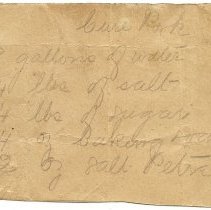Archive Record
Images

Metadata
Catalog Number |
2005.1.215.14 |
Object Name |
Recipe |
Title |
Cure Pork |
Date |
c. 1920 |
Description |
A series of recipes written on scraps of paper belonging to the Greeniaus family. (.14) is for "Cure Pork". The recipe is written as follows: "Cure Pork 8 gallons of water 14 lbs of salt 4 lbs of sugar 4 oz baking soda 2 oz salt petra" |
History |
This recipe card belonged to the Greeniaus family who lived in the historic Village of Sheridan, in historic Mississauga. Meat preservation posed a constant challenge for early settlers before widespread refrigeration. Common methods included salting, smoking, and spicing, which not only preserved meat but also enhanced its flavor. Curing, a process involving heavy salting, served as the initial step in smoking meat, extracting water and eliminating decay-causing microorganisms, thus prolonging its shelf life. Additional ingredients like sugar or honey were sometimes added for flavor and tenderness. Curing could be done through dry-curing or brine-curing, with the latter being employed in this recipe. In brine curing, the curing mixture is dissolved in water, with settlers often gauging salt levels by observing whether a raw potato placed in the liquid floated. The meat is submerged in the brine, skin down, and packed until the brine reaches the top of an airtight, nonmetal container like a stoneware crock, with weights placed on top to keep it submerged. Brining times varied from 3-5 days for most meats, longer for larger cuts. After curing, the meat would be excessively salty and required desalination by soaking in cold water, scrubbing off salt, and thorough cooking before consumption. |
References |
"Back to Basics: How to Learn and Enjoy our Traditional Skills", Reader's Digest Association of Canada, Montreal, 1981. |
Search Terms |
Sheridan |
